Using Your English Combs [ Using Your English Combs (PDF, 958KB) ]
Wool combs prepare fibre for spinning by removing the short cuts, most of the vegetable matter, and aligning the fibres. If you are careful and always place the cut edge of the fibre onto the first comb and then transfer from one comb to the other an even number of times you will create the perfect worsted yarn. They work best on fibre that is dry and clean of oil or grease.
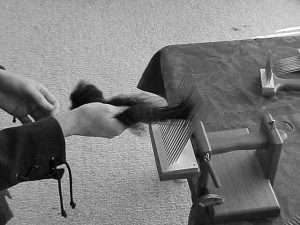 Clamp the comb base to a sturdy bench or table, insert one of the combs into the base and put the locking pin into place. Your fibre is attached to one comb by grasping a lock of your fleece and catching the butt end on the first rows of tines of the comb. If your fibre extends too far out the back of the tines you will have a lot more waste. Load the comb about one third of the height of the first row.
Clamp the comb base to a sturdy bench or table, insert one of the combs into the base and put the locking pin into place. Your fibre is attached to one comb by grasping a lock of your fleece and catching the butt end on the first rows of tines of the comb. If your fibre extends too far out the back of the tines you will have a lot more waste. Load the comb about one third of the height of the first row.
Note: twisted and curly fleeces eg suri and mohair may comb better with the tip end loaded onto the comb first.
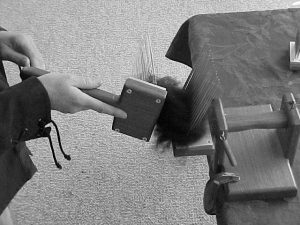 The fibre is then transferred to the second comb by combing the wool at a ninety-degree angle. Comb from right to left and from left to right—slightly tilt the comb towards the floor so the fibre on the stationary comb stays down on the tines.
The fibre is then transferred to the second comb by combing the wool at a ninety-degree angle. Comb from right to left and from left to right—slightly tilt the comb towards the floor so the fibre on the stationary comb stays down on the tines.
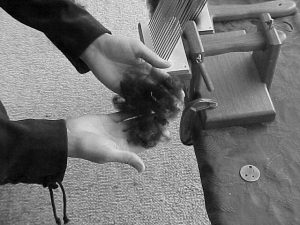 When no more can be transferred to the second comb remove the short fibres and vegetable matter which has become trapped in the tines on the first comb.
When no more can be transferred to the second comb remove the short fibres and vegetable matter which has become trapped in the tines on the first comb.
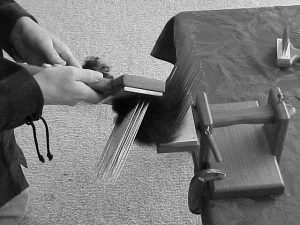 To transfer the fibre back onto the empty comb you can either swap the combs over and repeat the step above, or you can pull the comb down at a ninety degree angle (turn this comb over every now and again so it is facing the other direction) catching the fibre onto the stationary comb. The amount of times you need to repeat this process depends on the type and quality of fibre being used and the end result you want.
To transfer the fibre back onto the empty comb you can either swap the combs over and repeat the step above, or you can pull the comb down at a ninety degree angle (turn this comb over every now and again so it is facing the other direction) catching the fibre onto the stationary comb. The amount of times you need to repeat this process depends on the type and quality of fibre being used and the end result you want.
 To create a top that will make your spinning a dream, draw off your fibre hand over hand or use a diz. A diz can be made of wood, plastic, bone, shell or metal. By threading your combed fibre through the hole it will help you pull fibre off the comb into a uniform continuous top. With your comb in the clamped base base and using the diz threader, twist a section of the combed fibre and pull the fibre through one of the holes in the diz. Pinch the fibre with your thumb and index finger and gently pull them away from the diz, approximately 5cm or about one third of the staple length. The diz will move out with them so after each draw push it back towards the comb. If you push the diz to far toward the comb it will be hard to draw through the fibre, if the diz is too far away from the combed fibre the top will become thin and possibly break.
To create a top that will make your spinning a dream, draw off your fibre hand over hand or use a diz. A diz can be made of wood, plastic, bone, shell or metal. By threading your combed fibre through the hole it will help you pull fibre off the comb into a uniform continuous top. With your comb in the clamped base base and using the diz threader, twist a section of the combed fibre and pull the fibre through one of the holes in the diz. Pinch the fibre with your thumb and index finger and gently pull them away from the diz, approximately 5cm or about one third of the staple length. The diz will move out with them so after each draw push it back towards the comb. If you push the diz to far toward the comb it will be hard to draw through the fibre, if the diz is too far away from the combed fibre the top will become thin and possibly break.
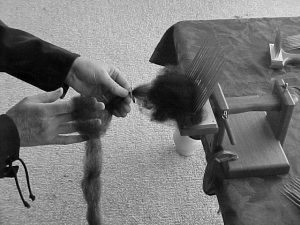 Keep doing the pinch and pull technique until all of the combed fibre has been removed. There is a knack to using the diz, but once mastered you will be surprised at just how much faster and more even you will be able to spin.
Keep doing the pinch and pull technique until all of the combed fibre has been removed. There is a knack to using the diz, but once mastered you will be surprised at just how much faster and more even you will be able to spin.
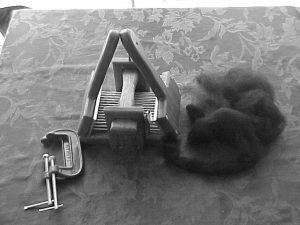 When not in use the two combs can be slid together and sit on the wooden base: the handle locks into place where the comb was. I don’t recommend you pick up the set by the handle as the combs could slip off—pick the set up by using both hands.
When not in use the two combs can be slid together and sit on the wooden base: the handle locks into place where the comb was. I don’t recommend you pick up the set by the handle as the combs could slip off—pick the set up by using both hands.
If you happen to bend a tine, I find the best straightening tool is our tine straightener (sold separately) or a thin piece of pipe. A set of small pointy nose pliers can be useful as well.
Like most things practice makes perfect, but I can guarantee that once you have the wool comb bug it will be difficult to return to your previous fibre preparation method. Please contact me if you have any questions. Also I would like you to let me know about the types of fibre you are using and the results you obtained and if you have any hints or tips about their use. I can then pass these on to new users.
Happy combing!
Julie Hofer
Petlyn Fibre Products
‘Petlyn Park’, 122 Bungowannah Road, Jindera NSW 2642 Australia
Phone: +61 (0)2 6026 3835
Email: fibreproducts@petlyn.com.au
